Overview
We live in a big world full of interesting people and places. Sometimes it takes a board game to get us there. Vital Lacerda introduced a lot of us to Lisboa. Uwe Rosenberg immersed us in the lives and the culture of the Vikings. J. Alex Kevern taught us about the Chinese village of Daxu. Now it’s Stefan Dorra’s turn. Fifty miles south of Italy’s most southern point lies the small island nation of Malta. Residing on the largest of Malta’s three main landmasses and nestled within the embrace of Malta’s Grand and Marsamxett Harbours lies the capital city of Valletta, the title and inspiration for this game.
Originally conceived by its namesake, Jean Parisot de Vallette in 1566, construction of the city was not completed until sometime in the 1570s. Neither de Vallette or the city’s principal designer Francesco Laparelli would live to see its completion, but their vision for the city would guide those who came after them. The idea was to build Valletta on a rectangular grid plan with wide, straight streets beginning from the City Gate and ending at Fort Saint Elmo which overlooks the Mediterranean. The game takes place during this period of construction and commerce.
Valletta is, at its heart, a deck building game, but there’s so much more to it. The players take on the roles of foremen who are in charge of the various construction projects. Each player will guide their team of workers as they work to obtain the materials and resources that will be needed to build the various structures within the city. Building these structures provides the players with new cards and new abilities as well as the victory points that they will need to win the game. When the game finally reaches its conclusion, the player with the most victory points will be declared the winner.
Setup
The setup for Valletta is probably the most convoluted and time-consuming aspect of the game. First, the two-section road board is assembled and laid out in the middle of the table. There are three different decks of building cards in three colors – yellow, blue, and green – and, depending on player count, a certain number of each color is randomly selected and the chosen cards are shuffled into a single deck. These cards are then dealt five cards at a time above the road board and then below it in an alternating fashion. Depending on the number of players, there will be between four and six rows of five cards each when this has been done. Next, you will find the character cards that are associated with each of the randomly selected buildings (there are matching letters on the buildings and the character cards) and these cards will be laid on top of their respective buildings.
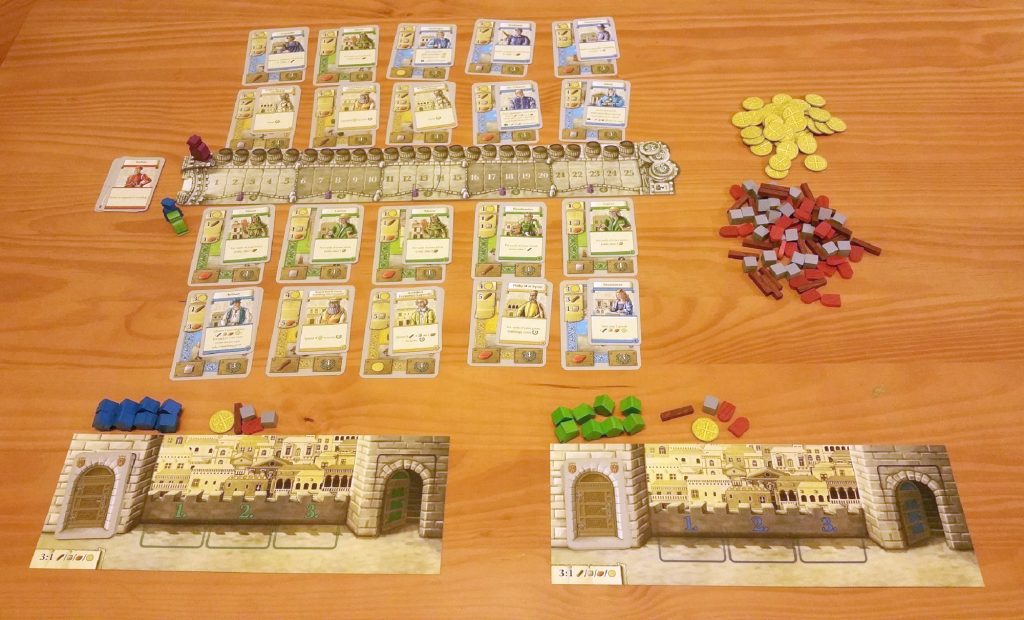
After the cards have been laid out, each player selects a color and takes all of the pieces and starting cards, along with the player board, of the chosen color. Their player figure is set at the beginning of the road (which represents the road running from the city gate to Fort Saint Elmo) and the Jean Parisot De Vallette (referred to as J.P. from here on out) pawn is placed onto the leftmost tower. The barrel tiles are placed face down, shuffled, and then put onto the spaces to the right of the tower along the top part of the road board. The extra builder cards are also placed next to the road board. Once this has been completed, all of the resource bits are separated and placed into supply piles closeby. Each player receives one of each resource – wood, gold, brick, and stone. Then a separate collection of each resource is set aside. Once a starting player has been decided, each player in turn order will select one of these resources to add to their starting supply. Then you’re ready to begin.
Your Starting Team
During a turn, each player will be playing three of the five cards that will be in their hand to their player board. Each player board has locations for the cards and the order that they are played in can be of some significance.
The players all begin the game with the same set of eight character cards. Five of the cards are used to collect resources: one collects wood, another collects stone, brick, coin, etc. and one that will provide you with a single resource of your choice. In addition to these resource cards are the Builder, the Apprentice, and J.P. The builder, when played, will allow you to either construct a new building or upgrade a structure which you have already built. We’ll get to this momentarily. The Apprentice will allow you to copy the ability of the card that was played directly before it as long as that card is either green or red.
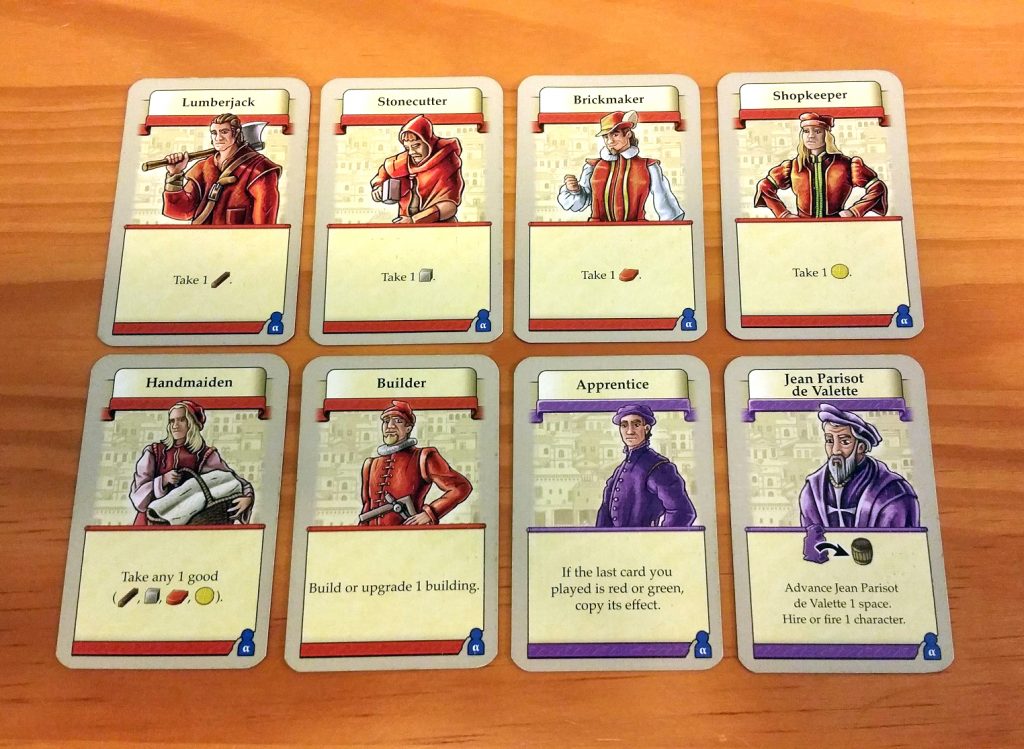
The J.P. card has several functions that it can perform when it is played. First, playing J.P. will advance the J.P. pawn one space along the bridge. When this piece advances into a space the barrel tile that is there gets flipped over and the player that caused J.P. to move receives the resource depicted on the tile and the tile is removed from the game. Secondly, advancing J.P. gives the player an opportunity to either fire a character (discard a character card from their hand) or to hire a character card (select one of the cards from that same pile). Moving J.P. along this track also has the potential to affect scoring during a building turn and can even bring the game to an end if the conditions are right.
Construction and Upgrading
Constructing a building is as easy as paying the costs associated with building the structure to the supply, taking the card from the building and adding it to your hand, and then placing one of your houses onto the card. There are several things to consider when building a structure that might affect your decision of which building you want to build.
Each card in each row belongs to a column of cards. The road board is divided into five sections that correspond to these columns. If the building that you are paying to build is in the same column that J.P. happens to be in, then you will receive two victory points for constructing it and move your player figure up an appropriate number of spaces along the road board. This is the first consideration. The other considerations have more to do with the buildings themselves.

Another consideration is the building’s point value. Each building is worth a certain number of victory points (shown in the bottom right corner of the card) at the end of the game. The higher point values are typically harder to build while the lower point values are much simpler in terms of resource costs.
Yet another consideration is the card associated with the building. The green buildings typically provide character cards that are upgraded versions of your starter character cards. The blue buildings typically provide some sort of income boost by multiplying the effect of other cards, stealing resources from other players, getting free stuff, among others. The yellow cards provide the players with opportunities to outright purchase instant victory points by paying money, resources, or some mixture of the two to do so. In addition to the card effects, the buildings themselves also have icons in the bottom left corner. Some cards provide resources based on how many of a specific icon there are on the buildings that you control.
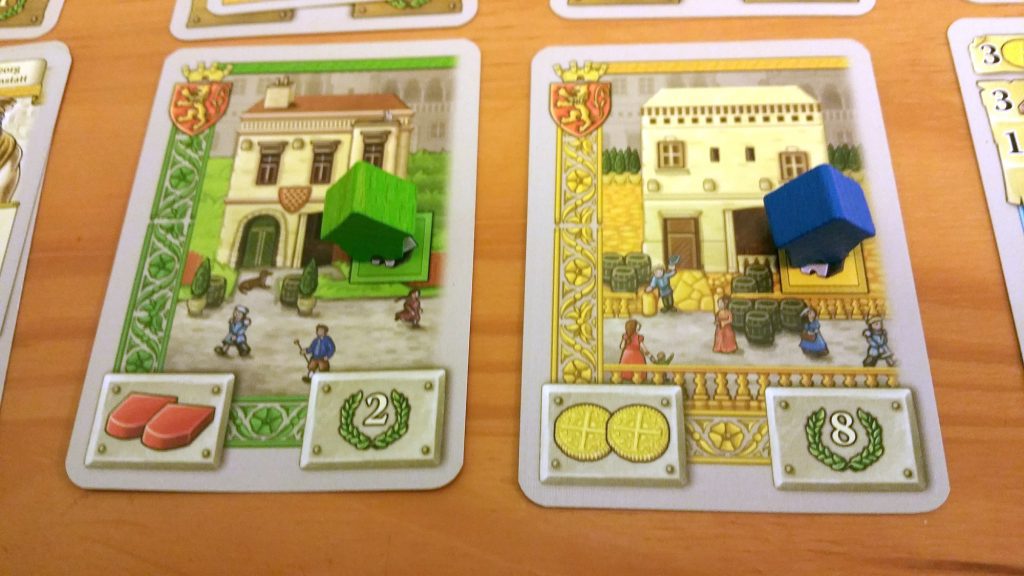
Once you’ve constructed buildings, you will have an opportunity to upgrade them during future turns. To upgrade a building, you will pay the original building costs minus the gold component and then flip the card to its opposite side. This doubles the icon associated with the building as well as its end game victory point value.
Endgame and Scoring
The end of the game is triggered in one of three ways:
- A player places their final house
- J.P. reaches the 25th space on the road board
- A player reaches or passes the 25th space with their player figure
When one of these conditions are met, the player that caused the condition to be met finishes their turn and then all of the players shuffle their discard piles into their deck and play through their decks one more time. When all players have done so, they will add the point values from their buildings to any points they have already scored during the course of the game. They will also receive one point for every three leftover resources they have and this is added to their score. The player with the most points wins the game.
Thoughts
I had a realization recently: I love Klemens Franz’s artwork. A large percentage of the games that I own and enjoy have been illustrated by this remarkable artist. Whether I’m drawn to these games by his artwork or whether Klemens Franz happens to enjoy and gladly provides the artwork for the same types of games that I enjoy playing I couldn’t say. All I know is that I have thoroughly enjoyed pretty much every game that I’ve played that bears his name as the illustrator. Valletta is no different. I love the artwork and I absolutely adore this game.
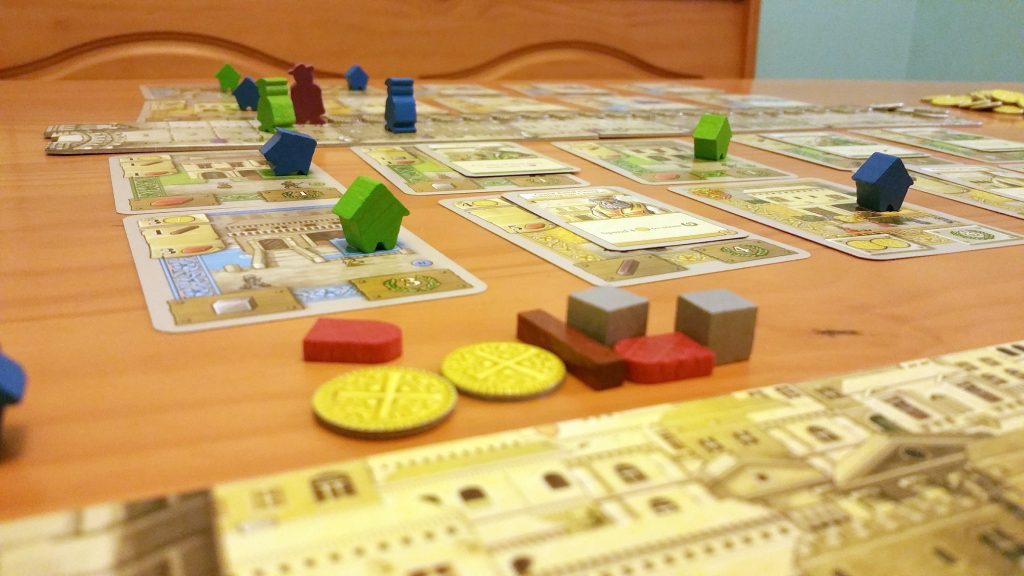
It begins with the components. As soon as you open the box, your are assailed with a myriad of wooden bits and cards. When I first saw photos of the game laid out in Spielbox Magazine, I knew that I wanted this game. The massive amount of colorful stuff just sang to me. The boards are thick and durable. The cards are thick and have linen finishes on them. The colors are bold and vibrant. There’s even a cleverly illustrated and well-designed divider built right into the box. My only complaint as far as the components go is that I wish the player mats were a little sturdier and I wish that the rule book and the separate card reference were simply condensed into a single volume. But that’s just the window dressing that drew me into the store. Where Valletta really excels is the game play.
I’m a big fan of games where I get to build things. Watching the board fill up with pieces in your color gives you a sense of ownership in the game and it’s generally just a good feeling as well. Valletta ties that directly into card acquisition. When you acquire a new card in most deckbuilders, that new card sits in your discard pile until it gets cycled back into your hand in future rounds. Since the cards in Valletta go directly into your hand, though, they become instantly available for you to use. Done cleverly, you can set yourself up with some very lucrative combos this way. I like that. It really speaks to the Magic: the Gathering player in me.
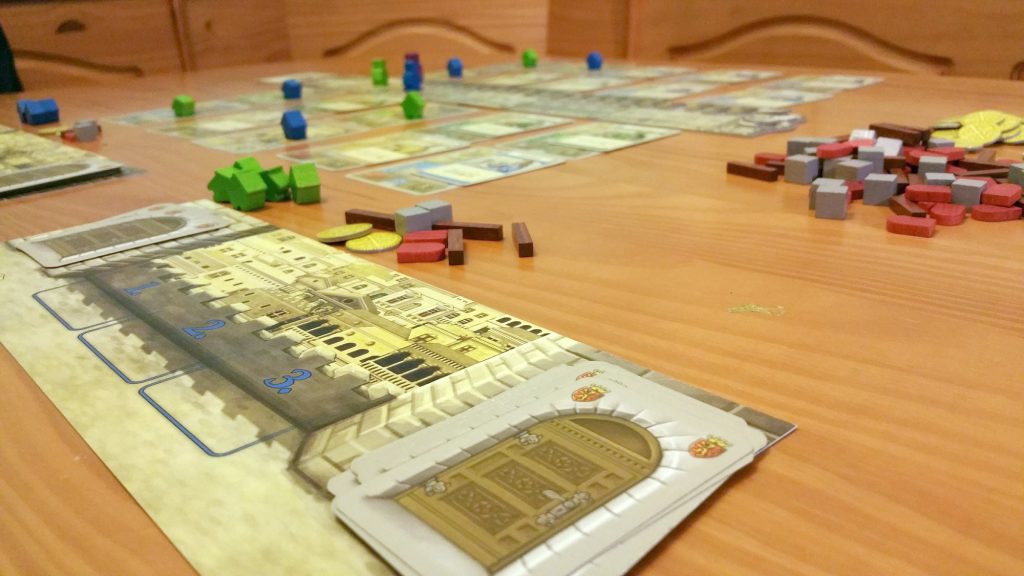
Most deckbuilders also see you discarding your unused cards at the end of your turn and then drawing back up to your maximum hand size. This constant discarding and drawing back up puts a lot of your success or lack thereof into the hands of fate. That doesn’t sit well with me. Valletta, on the other hand, only has you playing 3 out of the five cards in your hand and this encourages holding onto particular cards and planning for the future. For instance, if you’re holding onto a Woodworker (who gives you 1 wood for each of your wood icons), it might be in your best interest to hang onto him for when you’ve also got an Apprentice in your hand so that you can double up on his wood gathering ability. Since the resources in this game can be traded in at a 3:1 rate, the game also encourages you to carefully consider what you’ve got versus what you’re wanting to get. While snatching up a lot of cheap properties quickly might seem appealing, holding onto your resources for higher scoring buildings and better cards may be something that you want to consider.
Valletta manages to take all of this forward thinking and decision making and distill it down into a game that’s light and palatable. As a person that plays a lot of heavier games, I enjoy it, but it’s also easily accessible for people that are new to the hobby as well. It’s a game that scratches a lot of itches for me. It’s got deck building. It’s got hand management. It’s got resource collection and resource management. It presents a lot of opportunities for card comboing and planning and strategizing. And it takes all of these elements and mixes them up into something that, while feeling familiar and comforting, feels new and exciting. I love this game and highly recommend you give it a try!





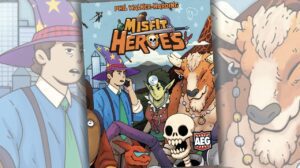





Add Comment